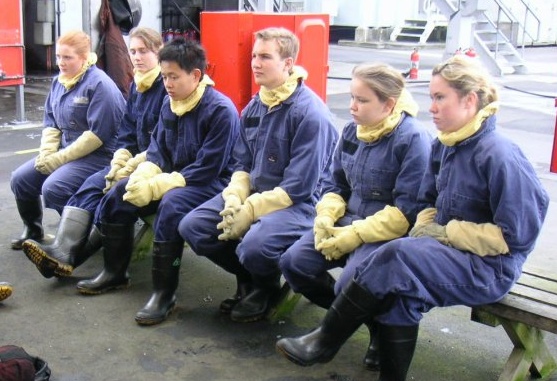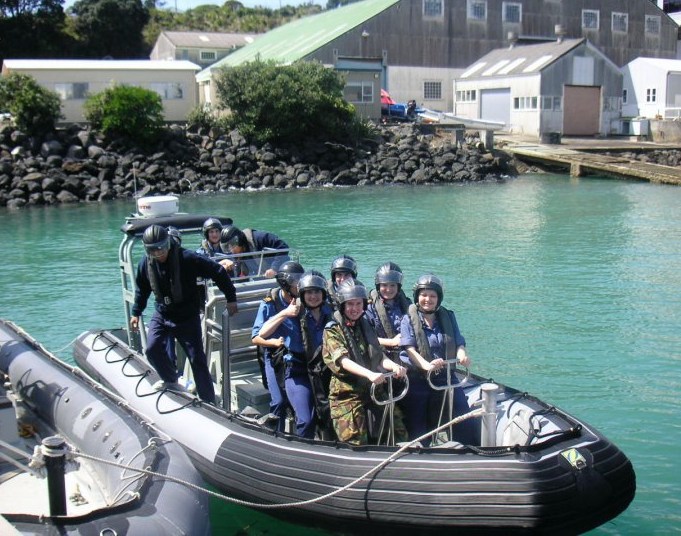Operation See Navy hosts HBHS Cadet

David Tang (Year 12) spent a week during the recent break investigating opportunities for a future career in the Navy. He and seven other teens were selected from applicants all over New Zealand to spend seven days on the naval base at Devonport. David enthusiastically reports that, among other things, he was tear gassed, submerged in a simulation of a sinking ship, required to put out fires, instructed using a frigate bridge simulator, and allowed to control a half million dollar navy harbour craft for several hours.
All of the exercises were carefully controlled, but authentic. They are used to train naval personnel in crucial survival and leadership skills in preparation for manoeuvres. The experience has honed David’s ability to perform under pressure, and has given him valuable insights into a career with the Navy. All of this was courtesy of the Royal New Zealand Navy and the New Zealand Cadet Forces, an organisation that David has belonged to for the last four years.
Interview with David Tang

How did you get selected for this trip?
I needed to write an essay about why I wanted to join the Royal New Zealand Navy, and be selected from the field of applicants. I found out about this through Cadets.
Tell us about Cadets…
‘Cadets’ is a youth organisation funded by the New Zealand Defence Force. Anyone can join between the age of 13 and 18. You learn leadership skills, outdoor and survival skills and have lots of trips funded by the government. You gain confidence through community service and leadership courses. I spend two hours a week on Tuesday nights at Cadets. In summer we go sailing once a week on Sundays. We go out to Huntly – we’re Sea Cadets so we sail, but there are other forms of Cadets you can do. Hamilton has the only inland Sea Cadets unit in New Zealand because we have access to Huntly. My involvement in this has meant that I have gone from not knowing how to sail at all, to holding a second-place ranking in New Zealand in my racing class. All of this is funded by the state.
Describe for us specifically what you did during your week in Devonport.
On Monday we arrived and got to know each other. Technically it was a travelling day, so we had a chance to look around and enjoy the facilities. We spent the whole afternoon in the Rec Room; there was Sky TV, pool tables, dart boards, table tennis tables – more than enough to keep us occupied for a while.
On Tuesday we visited the Naval Marae, and were introduced to a little of the Navy’s history in this country. We also learnt about the New Zealand Defence Force’s contribution around the world. In the afternoon, I spent some very happy time sailing a brand new half-million dollar RHIB around the harbour. A RHIB is a rigid-hulled inflatable boat. Its main use is for reconnaissance and surveys, ship boarding, rescue missions and amphibious assault, stuff like that. It sits very high in the water and is really easy to manoeuvre. It can go from 40 to 0 knots in just over a second. If the Navy ever decided to install these boats at Rainbow’s End, Rainbow’s End would make a killing. They are awesome.
Wednesday morning had us visiting a bridge simulator. This is a massive Playstation-like thing with all of the controls of an ANZAC Class frigate. A frigate is a boat that weights a little less that 5000 tonnes, and normally has about a 150 people on board. We jumped in and got dizzy and seasick because the simulation of Auckland Harbour was so convincing.
In the afternoon we went to 6 Squadron RNZAF, which is the naval aviation support squadron based in Whenuapai. That is where the Navy helicopters are based. The Navy pilots fly the helicopters around and break them, and then the Airforce crews fix them, which seems like a pretty good deal. We have six Seasprite helicopters, which we were allowed to review at close quarters. We also visited 40 Squadron, which has the Hercules aircraft that everyone is familiar with. These planes are particularly cool because they can be landed pretty much anywhere – you don’t need a proper airstrip for them to touch down. We also had a look at some Boeing 757 VIP transport options for the Defence Forces. All in all, it was pretty interesting.
DC School happened on Thursday. This is where all navy personnel have to come and learn how to save a ship (using some frighteningly realistic simulations) before they can be posted out to sea,. In the morning, we learnt about different types of fires and how to put them out. Everyone is in charge of this when you are on a boat, because everyone is put at risk by this problem. You learn about the three types of fire extinguishers and how to use them, with the instructors.
After this, we went to the Flood Unit. The Flood Unit is a section of a ship that is put on land, mounted on hydraulics, and has water pumping in and out of different compartments while you are stuck inside it. This was really intense, and definitely something you don’t want to do if you have claustrophobia. When the ‘boat’ started rolling and the water got to chest-height, people started screaming and freezing with panic. The water was really cold, which added to the stress of the situation. Hypothermia kicks in no matter how much insulation you are wearing, and it really challenges one’s leadership abilities.
The instructor sent me through the escape hatch in the Unit first, which I realised afterwards was a compliment, because he thought I could handle it. Going through first means that you climb up a small ladder, open the hatch and then have thirty litres of water pour down on top of your head at high speed. I thought briefly that I might be drowning. People were getting really scared at that point, and we went through the process of abandoning the ship. The instructors deliberately gave us faulty equipment so that we couldn’t save the ship anyway. We found out that the point of the exercise is to accomplish the tasks under extreme pressure. The three core values of the navy which are commitment, courage and comradeship – the Flood Unit tests these values thoroughly.
In the afternoon we went to the Nuclear, Biological and Chemical Centre. The instructors tear-gassed us to make sure that we had learnt to use the gas masks properly to protect ourselves. We also learnt how to clean ourselves if there was a nuclear disaster (the cleaning takes forever, but it’s not effective; if you’re exposed to that stuff you’re probably still going to be burnt or die later from poisoning or cancer). Getting tear gassed is extreme – some people vomit as well as crying. This isn’t what I necessarily expected to be doing during my holidays, but I’m really glad I did it.
Finally we went to the Fire Unit. This was in another sector of the same chopped-up ship which is designed to ‘spontaneously’ catch fire in different places. We had to put on gas masks and get the fires out using the right equipment. There were only eight people on the course so it was really clear whether or not you knew what you were doing. It was completely dark for the entire simulation, so we then had to navigate our way through the section of the ship without any visual prompts. We managed to do this successfully, but the other team didn’t. It’s a bit scary to think about what that would mean in real life.
Finally, we had a short tour around Devonport Naval Base on Friday. I saw all of the new ships from the Protector Fleet, which were pretty flash.
What do you see yourself doing in the future?
Hopefully I will get a scholarship from the Navy, go to university and become a Marine Engineer Officer for the Royal New Zealand Navy. I would absolutely recommend the Cadets to anyone who is interested. They offer really important opportunities for personal growth, travel and education, which can help you at school as well as in your future career. Cadets have taken me to many places both domestically and internationally, I've been flown down to Linton army camp for my Senior Leaders Course and Canada for the Canadian Navy Centennial. Next year in July I will be traveling to Singapore for the International Singapore Navy Exchange which I'm really looking forward to. Everyone should know that there is no expectation that getting into the Cadets means that you have to sign up with the Defence Forces. There is no pressure to do this – only to be the best person you can be. It’s a truly great experience.
Back to News

